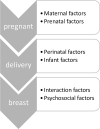Multifactorial influence on duration of exclusive breastfeeding; a Danish cohort study
- PMID: 32870906
- PMCID: PMC7462295
- DOI: 10.1371/journal.pone.0238363
Multifactorial influence on duration of exclusive breastfeeding; a Danish cohort study
Abstract
The multifactorial aspects of breastfeeding require measures at many levels to identify mothers in need of breastfeeding support from healthcare professionals. Our objective was to examine the relative importance of sociodemographic, pre/perinatal-, infant-, psychosocial-, and interaction-related factors affecting duration of exclusive breastfeeding. We used self-reported data from a community-based trial including 1265 women (response rate 49%) giving birth from January 2017 to February 2018. Data on outcome, duration of exclusive breastfeeding, were collected three and nine months postpartum; data on the study variables concerning known risk factors for breastfeeding cessation were collected two weeks postpartum. Crude and multiple Cox proportional hazards models were used for statistical analyses with additional analyses for time varying effects. Factors with an independent prognostic influence on duration of exclusive breastfeeding in fully adjusted models included early skin-to-skin contact (HR = 1.18 CI:1.04-1.33), intention to breastfeed (HR = 0.77 CI: 0.73-0.80), positive outcome evaluation, meaning the value mothers attributed to breastfeeding (HR = 1.33 CI: 1.08-1.63), higher level of self-efficacy (HR = 1.46 CI: 1.24-1.72), and maternal sense of security in relation to breastfeeding (HR = 1.31 CI: 1.14-1.50). Higher maternal BMI, lower self-efficacy, shorter breastfeeding duration of previous child, and hospitalization during birth were time dependent by affecting the exclusive breastfeeding duration primarily in the first months following birth. The results suggest that target groups in special need of early breastfeeding support are defined by being hospitalized, obese, having low self-efficacy or short previous breastfeeding experience. The extensive influence of psychosocial factors emphasizes the importance of including both practical facilitating guidance and positive verbal encouragement to ensure effective breastfeeding support.
Conflict of interest statement
The authors have declared that no competing interests exist.
Figures


Similar articles
-
The role of intention and self-efficacy on the association between breastfeeding of first and second child, a Danish cohort study.BMC Pregnancy Childbirth. 2018 Nov 22;18(1):454. doi: 10.1186/s12884-018-2086-5. BMC Pregnancy Childbirth. 2018. PMID: 30466403 Free PMC article.
-
Obesity and early cessation of breastfeeding in Denmark.Eur J Public Health. 2013 Apr;23(2):316-22. doi: 10.1093/eurpub/cks135. Epub 2012 Sep 29. Eur J Public Health. 2013. PMID: 23024342
-
The influence of psychosocial factors on the duration of breastfeeding.Scand J Public Health. 2004;32(3):210-6. doi: 10.1080/14034940310019218. Scand J Public Health. 2004. PMID: 15204182
-
Maternal Body Mass Index and Breastfeeding Non-Initiation and Cessation: A Quantitative Review of the Literature.Nutrients. 2020 Sep 2;12(9):2684. doi: 10.3390/nu12092684. Nutrients. 2020. PMID: 32887461 Free PMC article. Review.
-
A systematic review examining the association between female body image and the intention, initiation and duration of post-partum infant feeding methods (breastfeeding vs bottle-feeding).J Health Psychol. 2020 Feb;25(2):207-226. doi: 10.1177/1359105319833744. Epub 2019 Mar 15. J Health Psychol. 2020. PMID: 30873876
Cited by
-
Factors Associated with (Exclusive) Breastfeeding Duration-Results of the SUKIE-Study.Nutrients. 2022 Apr 20;14(9):1704. doi: 10.3390/nu14091704. Nutrients. 2022. PMID: 35565672 Free PMC article.
-
The role of breastfeeding self-efficacy in the relationship between perinatal depressive symptoms and exclusive breastfeeding: a longitudinal mediation analysis.BMC Pregnancy Childbirth. 2025 Mar 27;25(1):356. doi: 10.1186/s12884-025-07481-8. BMC Pregnancy Childbirth. 2025. PMID: 40148822 Free PMC article.
-
A correlational study of breastfeeding duration among Saudi mothers: The role of self-efficacy, intention, and social support.Belitung Nurs J. 2023 Apr 18;9(2):132-138. doi: 10.33546/bnj.2510. eCollection 2023. Belitung Nurs J. 2023. PMID: 37469583 Free PMC article.
-
Factors associated with early cessation of exclusive breast feeding among Saudi mothers: A prospective observational study.J Family Med Prim Care. 2021 Oct;10(10):3657-3663. doi: 10.4103/jfmpc.jfmpc_852_21. Epub 2021 Nov 5. J Family Med Prim Care. 2021. PMID: 34934662 Free PMC article.
-
Exclusive breastfeeding: an exploratory thematic analysis of the perspectives of breastfeeding mothers and significant others in the Tamale metropolis of Northern Ghana.BMC Nutr. 2024 Dec 18;10(1):161. doi: 10.1186/s40795-024-00973-4. BMC Nutr. 2024. PMID: 39696715 Free PMC article.
References
-
- World health organization (2001). The optimal duration of exclusive breastfeeding Report of an expert consultation. Geneva, WHO/NHD/01.09; Available from: https://www.who.int/nutrition/publications/infantfeeding/WHO_NHD_01.09/en/ (Accessed 2 Sept. 2019)

